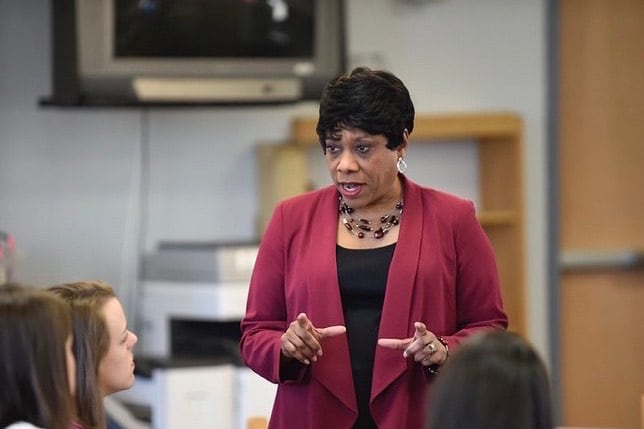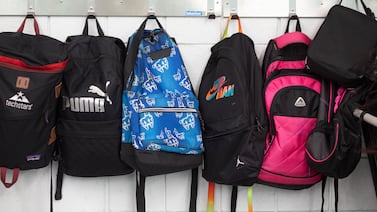Shortly after it became official that Becky Pringle would be the next head of the nation’s largest teachers union, she set the tone for her presidency with a tweet that ended like this: “We are ready to turn up that heat.”
In an interview Friday, the National Education Association’s incoming president said that means supporting local strikes or protests over teacher safety in the era of the coronavirus, filing lawsuits to block reopening plans that teachers see as unsafe, and other efforts to put teachers at the center of the national conversation.
“You saw that as our teachers came together in the Red for Ed movement,” Pringle said, referring to the wave of teacher activism in recent years calling for higher teacher pay and more school funding. Some educators went on strike, some didn’t, she noted. “But they were willing to come together as this powerful force and demand the resources their students and their schools needed. That is the kind of energy and power that I want to unleash.”
Pringle’s election comes as the U.S. continues to struggle to figure out how to reopen its schools. Nationally, COVID-19 case numbers have continued rising, and most of the country’s biggest school districts have decided to start the school year virtually. Other places are trying to maintain something closer to a regular year, with students attending at least part-time — including places like rural Tennessee, where caseloads remain relatively high, and many districts in Connecticut, where case numbers have dramatically receded.
As school boards and state health officials continue making those decisions, teachers have ramped up their protests over what they say are unsafe school reopening plans. Earlier this week, educators in several cities rallied in a national day of action, calling attention to issues like school cleanliness, poor ventilation in school buildings, and the lack of standard metrics for making reopening and closing decisions.
“I believe you will continue to see that stronger and stronger language coming from the state level, as well as the local level,” Pringle said. Responding to the pandemic is “very much a local issue,” she added, and the NEA is “not trying to say, you know, everybody should do this.”
Right now, national polls show parents, like teachers, are generally wary of sending students back into school buildings, and the Red for Ed movement had widespread public support. But there are continued challenges ahead for families that will struggle without child care and the extension of virtual instruction. Teachers may find it’s hard to stage walkouts or strikes that disrupt classes after a spring of remote instruction that fell short for many students.
Pringle said the union isn’t opposed to reopening schools in general, just reopening schools where community spread is high. And right now, she said, many places are picking and choosing which public health rules to follow. In some states, for example, students and staff are required to wear face coverings. In others, it will be optional.
The union’s other concern: Schools also need more money to pay for new coronavirus-related safety costs. Congress is still debating how much additional federal money to provide to K-12 schools in the next coronavirus relief package, even as the school year has begun in parts of the country.
She also pushed back on recent criticism from Republican members of Congress and others who say that teachers should be required to return to work like other essential workers. Educators are not only afraid of getting sick themselves, she said, but of passing the virus to students and their families.
“I don’t think being in front of a classroom of 30 students is like anything else,” she said. “You can’t make that comparison, and just say: ‘They are essential workers, so go back to work.’ You are responsible for students, their safety and their welfare, their learning, and their lives.”
Pringle said the union will also be focused on improving the quality of remote instruction, and making sure teachers have the training and support they need to “transform their lessons into really high-quality, engaging online lessons.”
“We’re not taking our eye off the ball of safety,” she said. But the union is going “to make sure that the learning that our students receive through the fall and winter, or however long we’re in this, continues to get better and better.”
Pringle will succeed Lily Eskelsen García as NEA’s president on Sept. 1, shortly before the 2020 presidential election. She’s already been in touch with Democratic presidential candidate Joe Biden — “I got a chance to talk with him last week,” Pringle said — and she plans to invest more of NEA’s resources into backing educator candidates for office, whether on school boards or in Congress.
Pringle is also an NEA veteran, having been a member of the union’s leadership team for more than a decade. She’s the union’s current vice president, and will be the union’s third Black female president.
But she started her 31-year career as a teacher in Philadelphia and then moved to a smaller suburban school district in Harrisburg, Pennsylvania, where she worked as a middle school science teacher.
She caught the eye of the local teachers union there after she spoke out against the large size of her son’s kindergarten class.
“You have a big mouth, and we need that,” the union’s president told her, according to The Philadelphia Inquirer.
Pringle says one of her top priorities will be continuing to work to address inequities in public education and trying to transform the system into a “racially just” one. Part of that is rooted in her own experience as a public school student in Philadelphia.
“I am someone who certainly did not come from means,” she said. “Like so many students today, I didn’t know from month to month whether we were going to be evicted from our home. My parents, of course, shielded me from knowing that I was poor.”
Pringle was in second grade when the school district started putting a desegregation plan into place, she said, and she recalls seeing white students and their families leave her elementary school. “Overnight,” she said, “my school became entirely Black.”
She later tested into one of the city’s most prestigious high schools, where she had access to advanced courses and well-equipped science labs, but had very few Black classmates.
“I saw the disparity right before my eyes,” she said.
She knows that her presidency is about to begin at a time of “twin pandemics,” as she put it, referring to both the coronavirus that’s upended teaching and learning and the national reckoning over institutional racism following the police killing of George Floyd.
“As difficult as this moment is,” she said, “you can’t deal with things like that unless you bring them to the surface.”








